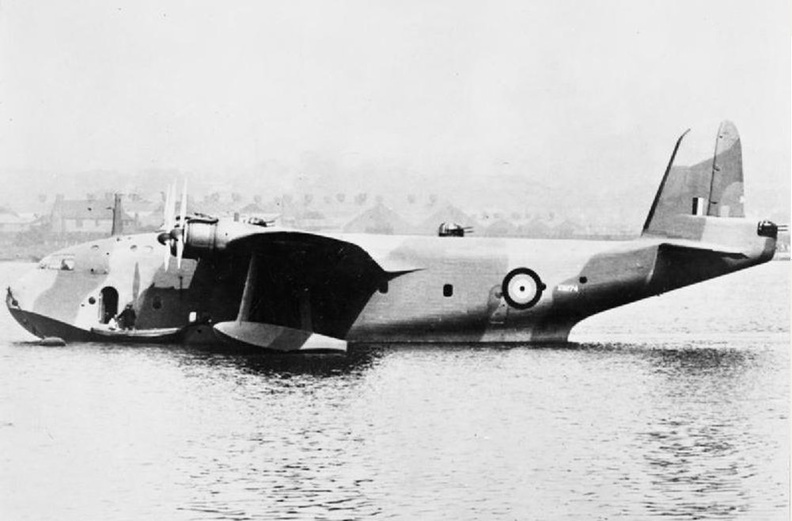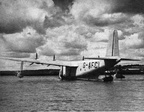
ADF-SERIALS
Australian
& New Zealand Military Aircraft Serials & History
RAAF
Short S.26/M "G Class"
10 Sqn, RAAF
Three Short S.26 G-class aircraft were built for Imperial Airways, subsidised by the Air Ministry in anticipation of military use.
When converted to the S.26/M version, the aircraft had defensive armament of 12 x 0.303 inch machine guns in two dorsal, and one tail, Boulton Paul BPA Mk II four-gun turrets. Offensive armament was eight 500 lb (227 kg) bombs under the wings. There was internal stowage for 20 reconnaissance flares, 28 flame floats and 8 smoke floats. Air to surface vessel (ASV) radar was fitted, plus armour plating for the internal fuel tanks and the crew stations.
Two of the aircraft were handed over to Imperial Airways for crew training, in 1940 all three were impressed (along with their crews) into the RAF, before they could start civilian operation. They were modified by Shorts to S.26/M military configuration before delivery to the RAF. After modification at Rochester, Airborne Surveillance Radar was fitted by Blackburn Aircraft Limited at Dumbarton in Scotland.
From 1941, the G-Boats served with No. 119 Squadron RAF and No. 10 Squadron RAAF, flying stores to Gibraltar and the Middle East before the two survivors were passed on to BOAC in December 1941.
| Serial | Type | CN | Civil
Registration |
Imperial Airways Name | Aircraft History |
| X8273 | S.26/M | S.873 | G-AFCK | Golden Horn | Third
S.26, 08/07/1940 First flight , ??/??/1940 Impressed by RAF and converted to S.26M Standard, ??/03/1941 119 Squadron, RAF, ??/10?1941 10 Squadron, RAAF ??/12/1941 Returned to BOAC and fitted out for 40 passengers in 'austerity' seating and operated between the UK and Nigeria, 09/01/1943 Lost at Lisbon. Engine seized and caught fire on a test flight following an engine overhaul. Crashed into the River Tagus at 10:30 am after a fire broke out aboard the plane. While attempting an emergency landing the ship porpoised and slamed back down and broke up. The separation of a cylinder may have thrown out oil and started the blaze. Aboard: 15 (passengers:11 crew:4). Fatalities: 13 (passengers:10 crew:3) |
| X8274 | S.26/M | S.872 | G-AFCJ | Golden Fleece | Second
S.26 24/02/1940 First Flight, ??/??/1940 Impressed by RAF and converted to S.26M Standard, ??/03/1941 119 Squadron, RAF, ??/??/1941 10 Squadron, RAAF ? 20/06/1941, Lost off Cape Finisterre on a flight from Mountbatten to Gibralter, when it broke up following a heavy forced-landing, due to the simultaneous failure of two engines. 10 Sqn Sunderland P9603 conducted a search. 10 Sqn RAAF Personnel missing on the "Golden Fleece" were: 40034 P/O J.Barry. 205741 LAC W.T.R.Crago. Fitter IIe (A/G) 4503 CPL L.G.Corcoran. Aircrafthand IIe (A/G) |
| X8275 | S.26/M | S.871 | G-AFCI | Golden Hind | First
S.26 21/07/1939 First Flight at Rochester by Shorts' chief test pilot, John Lankester Parker, ??/??/1940 Impressed by RAF and converted to S.26M Standard, ??/03/1941 119 Squadron, RAF, ??/10/1941 10 Squadron, RAAF ??/12/1941 Returned to BOAC and fitted out for 40 passengers in 'austerity' seating and operated between the UK and Nigeria, Golden Hind was employed on other routes in UK and West Africa until the end of the war, and remained in service with BOAC until retired in 1947, From 1947 till 1954 it lay moored in Rochester Harbour near its birthplace and where it had made its first flight, In 1954, whilst on a tow to a new anchorage it ran aground at Harty Ferry on the Isle of Sheppey and, with hull damage, was eventually scrapped. |
Page Author: Brendan Cowan.
Source: National Archives, British Military Aircraft Serials 1911-1979, Bruce Robertson, Australian War Memorial, Air Britain, 'Maritime is number 10': A history of 10 Squadron RAAF, the Sunderland era 1939 - 1945, K. C. Baff, (Netley: Griffin Press Limited, 1983), http://www.planecrashinfo.com, http://aviation-safety.net , National Archives of Australia ,
Emails: Martin Edwards,
Updated 29 November 2013
It is
our policy to only show historical events, no current
operational information will be displayed on this
website.
"The ADF-Serials team give permission to use
the content of this page, excluding images, providing
that it contains an acknowledgement to the adf-serials
team and any other listed sources."
![]()



